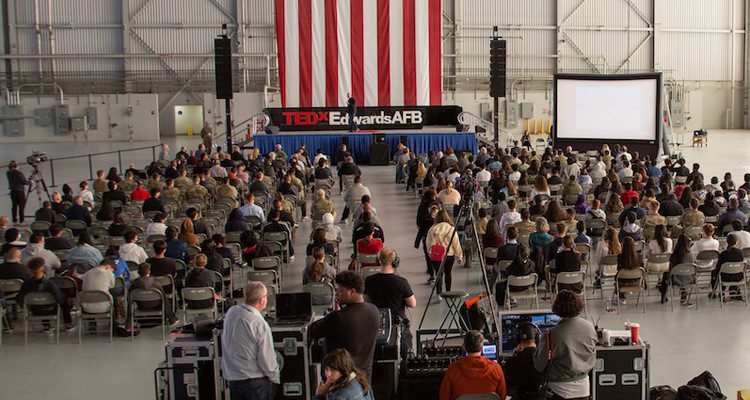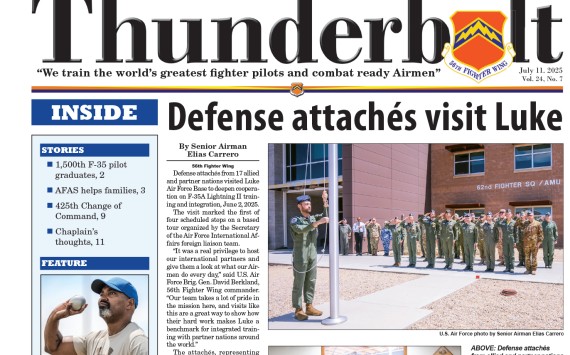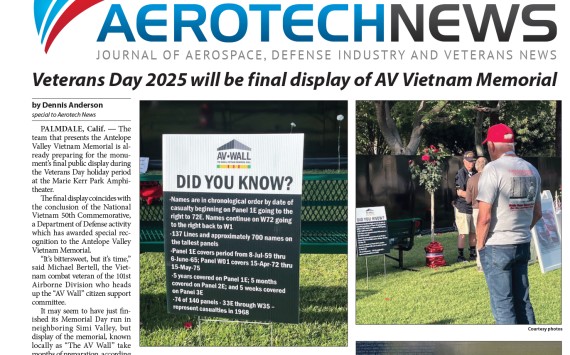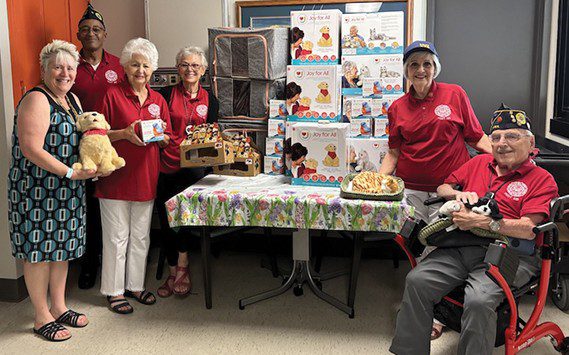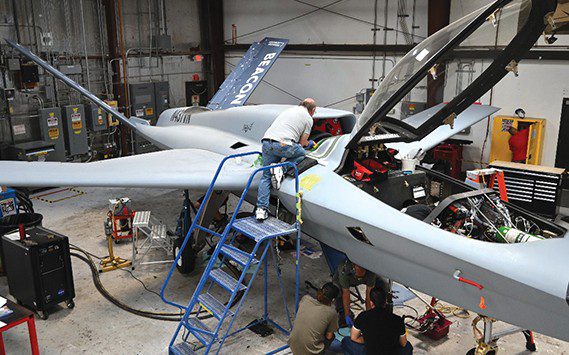TEDx Edwards brought together experts and innovators from military aviation, flight test, commercial space travel, artificial intelligence, and cyberspace on April 22, 2022.
With the subtitle of “Inspiring the Airmen of 2030 in Cyber, Space, and AI” the event was part pep rally and part technology conference intended to introduce high school students to futures in the Air Force and high tech.
Organizer Jared Thomas said he wanted to focus on the issues and wide-open opportunities the airmen of 2030 will face. He spent eight months planning the event, with co-organizer Britney Reed, and host Wendy Peterson, director of the 812th Test Support Squadron.
The last TEDx at Edwards was a half-day with “4 or 5 speakers and 120-150 people attending.
“This year, there were 22 speakers, 800 aspiring airmen in-person and 1,100 online on the day,” Thomas said.
“The beauty of TED is in how timeless many of the speaker’s talks are. I firmly believe that all of these remarkable speakers assisted in capturing the excitement, passions, and pride that contribute to what makes Edwards AFB The Center of the Aerospace Testing Universe (TCOTATU).”
Speakers and attendees included area business leaders, politicians, Air Force members, contractors, as well as entrepreneurs involved in cyber security, space tourism, aviation sustainability, and cleaning up space junk.
Students bussed in from high schools all over the Antelope Valley got a chance to see motivational speakers as well a static display of aircraft in one of the biggest hangars on Edwards AFB.
TED Talks evolved from the invitation-only TED Conference in 1990 in Monterey, Calif., where guests from varied disciplines spoke about their work and the future. In 2006, TED put speaker videos online, giving everyone access to the content. By 2009 TEDx was born, locally organized events licensed by TED but focused on the host community’s interests.
TED can disseminate TEDx videos if they choose but doesn’t allow organizers to do the same.
Edwards: Hot spot of aviation and test
Speaker after speaker paid tribute to Edwards AFB and the Air Force Test Center as the “center of the aerospace flight test universe,” as Brig. Gen. Matthew Higer, commander of the 412th Test Wing, described it.
The event was in the largest hangar on base, and Higer told attendees they were sitting “on hallowed ground in aerospace history and breathing rarefied air.”
Higer spoke directly to the hundreds of high school students seated on bleachers at the back of the hangar, “You are the future airmen of 2030. You are the future science and technology engineers, mathematicians and tech geeks — go geeks! — of our nation, that our nation needs right now.”
Making the point that not all innovation is on base, Lancaster City Manager Jason Caudle discussed plans to make their city hall the first to be run on hydrogen power. In 2015, the city started Lancaster Choice Energy — buying and selling energy, some of it generated by solar panels on schools and civic buildings. Now, they are building a hydrogen plant that will use plasma enhanced gasification to create hydrogen through bio-digesting green waste, and super-heating mixed paper waste.
From Poland to Pasadena
Art Chmielewski from NASA’s Jet Propulsion Lab in Pasadena, Calif., had a story of perseverance for the students. As a small boy on the roof of his 10-floor apartment in Poland, he gazed at the stars and dropped model landers he built and re-built when they crashed, until his mother put a stop to it. He decided then and there that “Space is for me!”
Later at University of Michigan, Chmielewski saw a JPL engineer talk about the Viking lander and decided that the Jet Propulsion Lab was where he wanted to be. Out of 11 post-graduation interviews he went on including JPL, he got 10 job offers — all but JPL. He went into their Pasadena facility and begged for an interview. Five times he was rebuffed, but succeeded on the sixth, and ended up working on Galileo, Cassini and black hole imaging.
Chmielewski said that students should “Study! You don’t have to be a mathematician” to work on space projects. But young people should be inquisitive. “Don’t play Fortnite, Grand Theft Auto; get out there.”
Video gaming can be beneficial
While Chmielewski discouraged video game play, Capt. Zach Baumann, a U.S. Air Force personnel research analyst and co-founder of the Air Force Gaming website, considers it a morale boosting, problem solving, team building activity. He said AF Gaming, where gamers connect on the DISCORD application, was born from a “passion for gaming, and a purpose for service.”
A 2020 Air Force study of 35,000 airmen said that 86 percent of respondents aged 18-34 identify as “gamers.”
In his Air Force job, Baumann seeks to connect “digital immigrants (today’s leaders) with digital natives (tomorrow’s leaders).” His website and frequent LinkedIn messages finally caught the attention of top leadership and partly resulted in the “Airman’s Gambit,” a Facebook Live game of chess between Baumann and retired Lt. Gen. Chris “Wedge” Weggeman.
Watched live by thousands, the game generated 275,000 messages, 350,000 voice mails, and allowed Baumann to say the “three coolest words ever: “Check. Mate. General.”
While AF Gaming began as a grassroots effort, it has now been taken over by the Air Force and has grown exponentially. Users play everything from tabletop games to the latest versions of Halo, Call of Duty, and Grand Theft Auto.
Not all base jobs are military
Media Fusion aerial photographer Ethan “Evac” Wagner, who has worked at Edwards for 12 years, said his success came because he “never said ‘no’ to any opportunity.
“Always say ‘yes,’ you never know where it will lead,” he said.
He started in administration, then company photographers needed someone to take public relations photos on the ground while they flew, so they asked if he would be interested.
That led to shooting C-17 hot brake tests on the runway, and finally pilot training so Wagner could photograph from a chase plane in the air. This led to flying in a T-38, F-15, F-18, and six years in the F-16.
Wagner told students that not all jobs on Edwards are in the military, and “you don’t have to figure things out in high school. You have time.”
Channel your inner Rock
Col. Randel J. Gordon, then vice commander of the 412th Test Wing at Edwards, gave a highly entertaining speech about “personas” and how your mental state can affect your performance on the job and in life.
Gordon used the example of stars creating alter egos to pump themselves up to perform — like Beyonce’s “Sasha Fierce” or Kobe Bryant’s “Black Mamba.” Bryant said he was inspired by Kill Bill, in which the main character uses the snake to kill. He became the Black Mamba on the court — “an assassin.”
“What you wear changes your mindset,” Gordon said to the students. “I’m ‘The Rock’ when I lace up and put on my gloves” for exercise, but when he comes home at night and changes out of his uniform, he’s Randy the family man.
David Nils Larson, senior adviser for Aero Flight Research, X-59 Project pilot at NASA Armstrong Flight Research Center at Edwards said he became interested in flight testing and space travel when a high school teacher gave him a copy of The Right Stuff.
NASA’s experimental X-59 Quesst (Quiet Supersonic Transport), built by Lockheed Martin, aims to prove that sonic booms can be quiet enough for supersonic X-planes to be flown over populated areas.
“Chuck Yeager broke the sound barrier here, and now the X-59 is going to fix it,” Larson said with a laugh. “I know we all love the boom, but not everyone does.”
Swami Iyer, president of Aerospace Systems, Virgin Galactic, and a former B-52 pilot, said that “the link between air and space is what Virgin Galactic is all about.” Virgin Galactic’s Spaceflight System (VSS) was developed at Mojave Air and Space Port, and Iyer said that “humanity’s access to space began here in Aerospace Valley.
He compared the views of space as comparable to the experience of “seeing the ocean for the first time as a child,” and said that it changes people. If you are a jerk, and “see that and come back still a jerk, it’s a terminal condition,” Iyer said with a laugh.
Beware of space junk
Gabriel Mounce, deputy director of SPACEWERX, Air Force Research Lab in New Mexico is involved in space sustainability, among other things. He told the audience that there are 40,000 pieces of space junk in orbit, and only 5,000 of those objects are operational. He said that the amount of space junk is equivalent to “600 garbage trucks full of compacted trash.”
“What if they hit a GPS satellite?” Mounce said, citing a list of everyday occurrences like banking, transportation and retail that would be affected, not to mention “field military services.”
Dr. Eileen Bjorkman, executive director of the AFTC, made the point that innovators often don’t know how their inventions and improvements will ultimately be used. The Air Force was in the lead developing global positioning satellites at Holloman AFB, N.M., but at one point zeroed out the budget because “in the 1970s and 80s, when they were first developing GPS, a lot of military people didn’t want it,” said Bjorkman. “They thought their navigation systems were good enough.” Luckily, cooler heads at the Pentagon vetoed the cuts.
It wasn’t until 1991, in the first Persian Gulf War, that U.S. Army soldiers trying to find their way around featureless landscapes found the navigation systems deemed “good enough” before were no longer adequate. Those soldiers started buying handheld GPS units on the civilian market and bringing them to the Persian Gulf, according to Bjorkman.
GPS is a now an integral part of everyday life and “what you are working on today might have applications you haven’t imagined,” she said. “Don’t let anybody tell you that innovation killer: ‘You don’t have a requirement’” for your project.
Another idea that was not initially accepted by the military came out of AI, according to Col. Tucker “Cinco” R.M. Hamilton, director of the Air Force/MIT Artificial Accelerator. In 2000, a ground collision avoidance system (GCAS) created with artificial intelligence was developed for the F-16 that took control away from the pilot at the last possible second if they were going to crash into the ground, and returned control when the danger was past.
But people didn’t trust it, “thought it would get in the way, and possibly cause accidents,” said Hamilton.
Auto GCAS wasn’t implemented until 2014, and in those 14 years, 17 F-16 pilots died. Since the United States started using system, 10 airplanes and 11 pilots’ lives have been saved.
Hamilton said that we need to stop being afraid that AI is going to take over. AI is just software that allows “machine learning.” It learns alongside humans, and we need to learn how to develop AI “ethically and responsibly.”
“AI is upon us; we are not doing enough to understand it or get ready for it,” Hamilton said. “It’s already here and we are late.”
Other speakers included Carrie Hernandez of Rebel Space Technologies Inc.; Lars Hoffman, senior vice president of Rocket Lab; Capt. Tyler “Kode” Brown, F-15E/EX Experimental Test Weapon Systems Officer, Eglin AFB, Fla.; Dr. David (Jester) G. Smith, director of Air Force Plant 42 in Palmdale, Calif.; Scott S. Shyne, chief of Information Warfare Division, Air Force Research Laboratory; Dr. Anita Sengupta, CEO and founder of Hydroplane Ltd.; Dr. Shawn Phillips, Ph.D, mission director and U.S. Space Force Guardian of Air Force Research Laboratory, Edwards AFB; Dr. Yevgeniya “Jane” Pinelis, chief of AI Assurance at DOD’s Joint Artificial Intelligence Center, Dr. Daniel Millman, Ph.D. chief technology officer at Stratolaunch; Victor Luquin, aerospace engineer, 73rd Test Squadron/Engineering Flight Science, Structures, Edwards AFB; Lauren Kruszewski, F-22 Structures lead, 773rd Test Squadron, Edwards AFB; Col. Jennifer M. Krolikowski, director and chief information officer, Space Systems Command, Los Angeles AFB.






